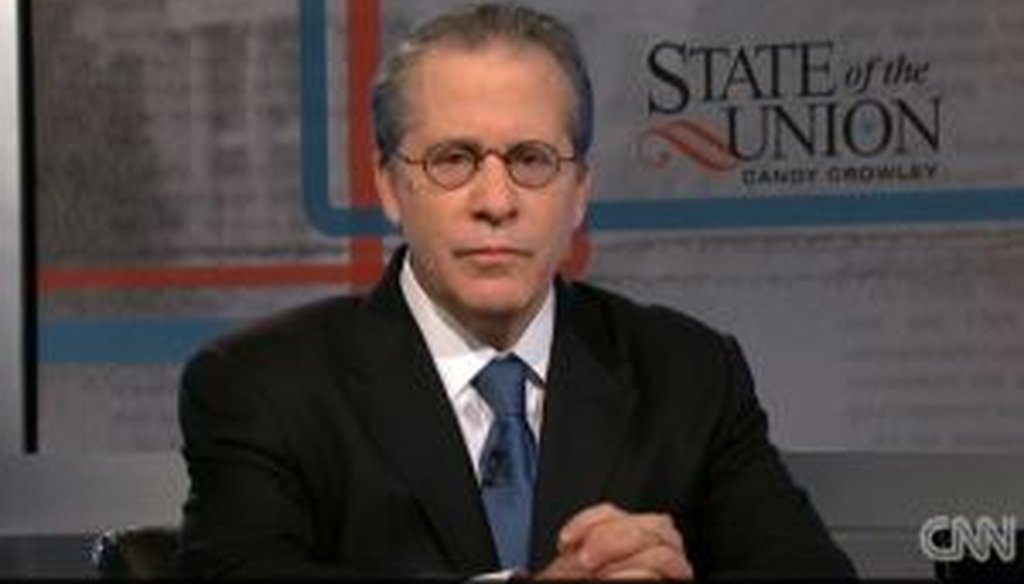

Our only agenda is to publish the truth so you can be an informed participant in democracy.
We need your help.


Gene Sperling, a key economic adviser to President Barack Obama, appeared on the Jan. 5, 2014, edition of CNN's "State of the Union."
About 1.3 million Americans rang in 2014 with a loss of long-term unemployment benefits, due to Congress’ failure to renew the Emergency Unemployment Compensation program before its Dec. 28 expiration.
Gene Sperling, a top economic adviser to President Barack Obama and director of the National Economic Council, is pushing Congress to extend the benefits. The Senate passed a key procedural hurdle Tuesday, but the House is not considered likely to follow suit.
To receive the benefits, the law requires that people actively look for jobs. On CNN’s State of the Union, Candy Crowley suggested that some people may be able to game the system. Sperling pushed back against that idea, emphasizing that a large majority of the unemployed are honestly trying to find jobs in a tough economy.
"Most of the people are desperately looking for jobs," he said. "You know, our economy still has three people looking for every job (opening)."
We thought we’d check whether Sperling’s ratio of people to job openings is on target.
To check the 3-to-1 ratio, we needed to know two things: the number of available jobs and the number of unemployed Americans. A White House spokesman referred us to a couple of Bureau of Labor Statistics reports.
There were 3.925 million job openings in October, according to the BLS Job Openings and Labor Turnover report from Dec. 10.
For an apples-to-apples comparison, we’ll use October unemployment numbers the BLS released in their Nov. 8 report, even though they’ve since published November data. They said 11.3 million people were unemployed. That just counts people who are actively looking for work, not those who have stopped looking due to discouragement or retirement.
That’s a ratio of 2.88-to-1 or, once you round off, roughly 3-to-1, just as Sperling said.
We should note a few caveats, though.
Tara Sinclair, George Washington University economics professor, pointed out that Sperling’s ratio isn’t perfect.
"The numbers that Sperling reported are about correct, but there is actually a lot more competition for jobs than that because many employed people are also applying for the same jobs that the unemployed are applying for," she said.
On the other hand, it’s worth noting that Sperling’s claim implies that for each job opening, there are three qualified applicants employers can choose from, but that’s a generous assumption.
"So it is possible for there to be a relatively high number of applicants for a job but employers may still feel like it is hard to hire because the people applying don't have the skills they are looking for," Sinclair said. "Or people may not apply to the jobs that are out there because they are not a good fit for any number of reasons."
James Sherk, a senior policy analyst at the Heritage Foundation, a conservative think tank, said Sperling’s statistic is good for comparing change over time. For example, Sherk said, the economy is worse now than it was in 2006, though the ratio has been improving steadily as of late.
Also worth noting is that many employers fill vacancies without publicizing them. According to one report, employers with no recorded vacancies at the end of a month account for 42 percent of hires in the next month.
That means the number of job openings the BLS survey records will always understate the actual number of openings.
Our ruling
Sperling said that in today’s economy, there are three people looking for work per job available. We crunched BLS numbers and got the same ratio, as did economists. The BLS data has shortcomings, some that would make the ratio higher and some that would make it lower. It also might not accurately reflect what the climate looks like from the perspective of employers or job seekers. Still, these are minor quibbles. We rate his statement True.
Bureau of Labor Statistics, "Job openings and labor turnover survey news release," Dec. 10, 2013
Bureau of Labor Statistics, "The employment situation -- October 2013," Nov. 8, 2013
CNN State of the Union, "Transcripts: Interview with Gene Sperling; interview with Scott Walker," Jan. 5, 2014
Email interview with Bobby Whithorne, White House spokesman, Jan. 6, 2014
Email interview with Edward Leamer, University of California Los Angeles economics professor, Jan. 6, 2014
Email and phone interviews with Tara Sinclair, George Washington University economics professor, Jan. 6, 2013
Huffington Post, "There are 3 unemployed people competing for every job opening," July 9, 2013
Phone interview with James Sherk, Heritage Foundation senior policy analyst, Jan. 7, 2014
University of Chicago, "The establishment-level behavior of vacancies and hiring," Dec. 30, 2012
Washington Post, "The Senate’s shocker on unemployment insurance -- and why it might not matter much," Jan. 7, 2013
Washington Post, "Seven things you should know about the expiration of unemployment benefits," Dec. 27, 2013
Washington Post, "Unemployment benefits for 1.3 million expire Saturday. Here’s why," Dec. 23, 2013
In a world of wild talk and fake news, help us stand up for the facts.
